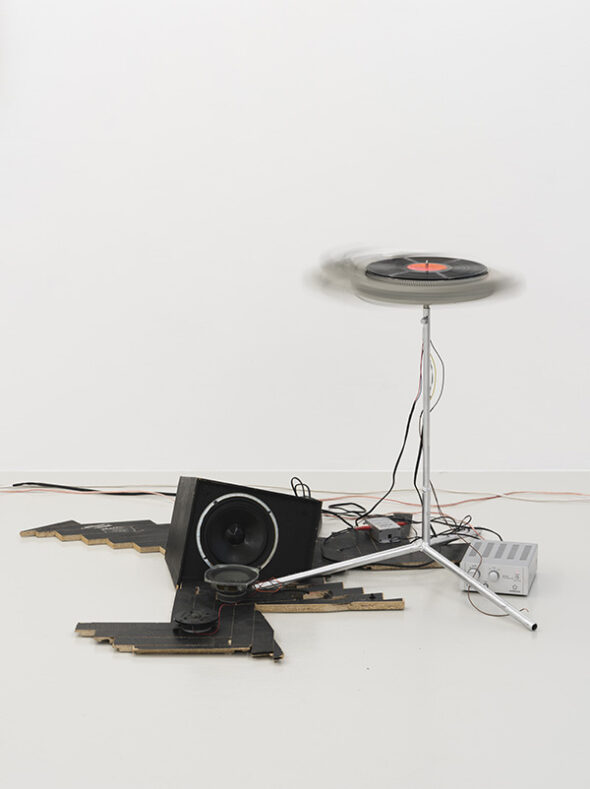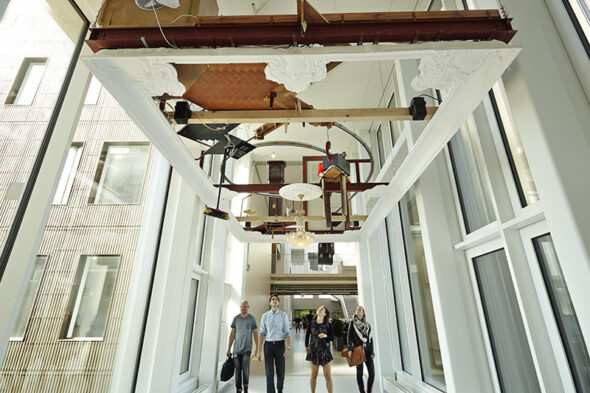by Johanna Hardt // Feb. 06, 2019
This article is part of our artist Spotlight Series.
Distant thunder, rainfall, winds howling, a murmur of a group speaking softly and unintelligibly, heavy breathing, creaky door hinges, footsteps on squeaky floors, eerie chords, heartbreaking sequences, deep rumblings, irregular noises, large wavelengths.
Reminiscent of horror films from the 1960s, the sonic installations of Vinyl -terror & -horror – the Berlin-based duo of Camilla Sørensen and Greta Christensen – create the feeling of suspense mixed with creeping uneasiness. They tease you with comforting sounds of familiar melodies only to interrupt them before you can truly get comfortable. You are left with the feeling of recognising the source, but remain irritated by the sense that you just can’t seem to pin it down. Rather than allowing you to dwell on the uneasy-yet-exciting nostalgic memories of this particular cinematic era and genre, their sonic installations are constantly drawing you back into the moment and location of their experience.
Their installation Time Escapes that was part of ‘Inside Out’ at Gether Contemporary makes the visitor acutely aware of their own position in the gallery by inducing a link between what is seen and what is heard: water dripping into a plastic cup – the sound of distant rain; the clock’s pendulum swinging heavily from one side to the other – the gloomy ticking of a metronome; a singular speaker driver lowered down in perpetual motion towards the gallery floor – a constant noise reaching higher frequency with duration. It’s easy to get caught up linking individual sculptural elements to individual audible components of the sonic composition.
Vinyl -terror & -horror describes sound as the place where they met. Having a background in sculpture, it comes as no surprise that they approach music materially. They deconstruct speakers that reassemble themselves, slice and cut up vinyls, recycle electronic components and build their dynamic installations out of domestic and everyday objects and self-built electronic equipment. This results in a communication between different bodies on the materiality in an acoustic event.

Vinyl -terror & -horror: Rellipsedalp, Off Track, Gether Contemporary // Photo Credits David Stjernholm
The apparent materiality in their compositional thought results in a grappling texture and creates an immersive, yet not automatically non-narrative, soundscape: experiencing their work of visual and sonic references in conjunction, their sonic installations build a dense complex that can be listened to in a linear way, unfolding like a narration through a fictional beginning, middle and end. Simultaneously, it has qualities of an immersive soundscape that leaves you negotiating the sound in space. You feel part of the space, while being dislocated from it; you feel like you are shaping it, while being transferred by it.
Due to their installations’ sonic, dynamic, almost theatrical qualities they often feel like concerts: functioning despite or, rather, because of, the apparent absence of performing subjects. We as visitors are able to witness not how the subjective interpretation of a performer finalises the composed piece, but rather how the distinct qualities of the manipulated speakers and devices shape the wavelength entering our ears. Thus, the work does not only refer to the medium that plays the sound and its role in shaping how the message is perceived. It, further, exemplifies how the situation, the context of its representation, implants itself in the feelings it evokes. The awareness of oneself creating a fictional narrative in conjunction with the automatic desire for a coherent story is a response to both what is heard and what is seen.

Vinyl -terror & -horror: Modulations in the horizontal mode // Photo Credits Anders Bigum




















